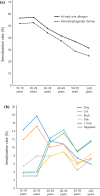Sensitization of common allergens and co-sensitization patterns in the Korean population
- PMID: 40258970
- PMCID: PMC12012044
- DOI: 10.1038/s41598-025-98470-6
Sensitization of common allergens and co-sensitization patterns in the Korean population
Abstract
Allergic diseases occur frequently and reduce the quality of life in patients with allergies. Many studies have investigated the pattern of various allergic antigens; however, studies on general patients are insufficient. Sensitization of allergens varies greatly depending on race or region. This study aims to investigate the sensitization of common allergens present in Korea and co-sensitization patterns among these allergens. We used data obtained from the Korea National Health and Nutrition Examination Survey conducted in 2019. Serum-specific immunoglobulin E levels were measured using the ImmunoCAP assay for Dermatophagoides farinae (Df), dog, cat, birch, oak, Japanese hop (J-hop), and ragweed. In addition, demographic data and responses to a questionnaire about rhinitis symptoms were obtained. The ImmunoCAP assay was performed on 2,397 out of 8,110 participants. The sensitization rate to at least one antigen was 45.2%. Df was the most common sensitized allergen (39.9%), followed by oak (11.2%), birch (10.2%), ragweed (8.7%), and cat (8.5%). Among the sensitized participants, 41.3% were sensitized to multiple antigens. In participants sensitized to a single allergen, 91.8% were sensitized to Df. In individuals sensitized to seasonal allergens, approximately 75% showed sensitization to Df too (birch: 74.6%, oak: 74.3%, J-hop: 74.3%, and ragweed: 76.3%). Around 90% exhibited co-sensitization with Df among individuals sensitized to perennial antigens (dog: 91.6% and cat: 88.7%). The allergen sensitization rate in the general population was about 41.3%. In addition, Df was co-sensitized to 75% of participants sensitized to seasonal allergens and 90% of participants sensitized to perennial allergens. Most allergens showed a tendency for sensitization to decrease with age, while some allergens exhibited peak sensitization at different age ranges. Further research is needed to explore these differences and their associations with co-sensitization. Moreover, studies are required to investigate how these cross-reactivity patterns are associated with patients' symptoms.
© 2025. The Author(s).
Conflict of interest statement
Declarations. Competing interests: We declare that this manuscript is original, has not been published before, and is not currently being considered for publication elsewhere. We confirm that all named authors have read and approved the manuscript and contributed to the work. There are no other persons who satisfied the criteria for authorship but are not listed. We further confirm that the order of authors listed in the manuscript has been approved by all authors.
Figures


Similar articles
-
Trends of Sensitization to Inhalant Allergens in Korean Children Over the Last 10 Years.Yonsei Med J. 2020 Sep;61(9):797-804. doi: 10.3349/ymj.2020.61.9.797. Yonsei Med J. 2020. PMID: 32882764 Free PMC article.
-
Co-sensitization to silkworm moth (Bombyx mori) and 9 inhalant allergens among allergic patients in Guangzhou, Southern China.PLoS One. 2014 May 1;9(5):e94776. doi: 10.1371/journal.pone.0094776. eCollection 2014. PLoS One. 2014. PMID: 24787549 Free PMC article.
-
Optimizing Identification of Allergic Sensitization to Seasonal Inhalant Allergens in the USA: Implications for Constructing Optimal Panels to Evaluate Patients with Allergy.Int Arch Allergy Immunol. 2024;185(9):848-855. doi: 10.1159/000538420. Epub 2024 May 23. Int Arch Allergy Immunol. 2024. PMID: 38781930
-
Analysis of Cross-Reactivity and Allergic Symptoms of 19 Allergens: Results from NHANES 2005-2006.Int Arch Allergy Immunol. 2022;183(2):176-185. doi: 10.1159/000518951. Epub 2021 Sep 21. Int Arch Allergy Immunol. 2022. PMID: 34547755
-
Sensitization to common allergens and its association with allergic disorders at age 4 years: a whole population birth cohort study.Pediatrics. 2001 Aug;108(2):E33. doi: 10.1542/peds.108.2.e33. Pediatrics. 2001. PMID: 11483843
Cited by
-
Special Issue "Molecular Mechanisms and Treatment of Allergic Reactions".Int J Mol Sci. 2025 Aug 1;26(15):7461. doi: 10.3390/ijms26157461. Int J Mol Sci. 2025. PMID: 40806588 Free PMC article.
References
-
- Asher, M. I. et al. Worldwide time trends in the prevalence of symptoms of asthma, allergic rhinoconjunctivitis, and eczema in childhood: ISAAC phases one and three repeat multicountry cross-sectional surveys. Lancet368, 733–743 (2006). - PubMed
-
- Zhang, Y., Lan, F. & Zhang, L. Advances and highlights in allergic rhinitis. Allergy76, 3383–3389 (2021). - PubMed
-
- Park, S. C. et al. Geographic and demographic variations of inhalant allergen sensitization in Koreans and non-Koreans. Allergol. Int.68, 68–76 (2019). - PubMed
MeSH terms
Substances
Grants and funding
LinkOut - more resources
Full Text Sources
Medical
Miscellaneous

